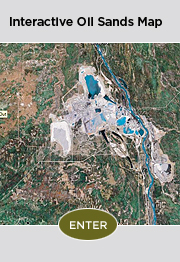- HOME
- |
- SIGN-UP
- |
- CONTACT US
- |
- SITE MAP
Fort McMurray & Area
Did you know...
Canada’s oil reserves are second in the world behind Saudi Arabia
Of 179 billion barrels of Canada’s oil reserves, the oil sands represent 97 per cent
For each permanent oil sands-related job, nine additional direct, indirect and induced jobs are created in Canada.
Currently 240,000 jobs in Canada are directly or indirectly linked to the oil sands.
Between 2000 and 2020, oil sands development has the potential to generate at least $123 billion in royalty and tax revenues for Canada’s federal and provincial governments.
The oil sands currently account for only 4.6 per cent of Canada’s greenhouse gas emissions. This is less than 0.1 per cent of total global emissions.
Alberta was the first jurisdiction in North America to legislate industrial greenhouse gas emission reductions.
Producers have made great strides in reducing the amount of emissions per barrel of bitumen extracted from the oil sands. The equivalent of 2.6 million tonnes of reductions have been made – the same as taking more than 550,000 cars off the road.
The province of Alberta has committed $4 billion toward climate change initiatives, including $2 billion for public transit and $2 billion for carbon capture and storage (CCS). This is the largest CCS investment in the world.
Air quality around oil sands operations is better than all North American cities reviewed by the Alberta Clean Air Strategic Alliance.
Alberta air quality standards are the most stringent in Canada.
Air quality in Fort McMurray is monitored around the clock. Results are available at the WBEA site.
Air quality has been extensively modeled and demonstrated to remain within Alberta’s strict air quality guidelines even with all projected oil sands development in place.
Oil sands are located below the surface of 140,200 square kilometres of land, 4.5 per cent of Canada’s total boreal forest.
Mineable oil sands only exist under 0.1 per cent of Canada’s total boreal forest.
While disturbance is occurring daily, in more than 40 years oil sands mining has disturbed about one hundredth of one per cent of the Canadian boreal forest – some 500 square kilometres.
Since 2001, coordinated efforts between government and industry through Integrated Landscape Management (ILM) activities have reduced land surface disturbance in the region by 20 per cent.
As required by law, and included in all project approvals, reclamation work is ongoing and continuous in the oil sands. All lands disturbed by oil sands will be reclaimed.
Mining is only an option for oil sands that sit less than 75 metres under the surface.
More than 80 per cent of the oil sands will be developed using in-situ technologies.
In-situ projects resemble conventional oil development and do not require tailings ponds, or mine pits.
In-situ operations create linear disturbance of the surface for wellheads. But new technology and processes, including low-impact seismic and directional drilling, are reducing that footprint.
In Alberta, Alberta Environment regulates oil and gas industry water use under the Water Act. Oil and gas companies are subject to the same conditions for use as any other licensed water user in Alberta.
Currently, the oil sands industry draws less than half the water allocation allowed by Alberta Environment from the Athabasca River.
Water allocations are strictly controlled during low flow periods.
More than 80 per cent of water drawn by industry from the Athabasca is recycled.
Non-potable water which is unsuitable for drinking, livestock or irrigation use is used wherever possible for in-situ production.
Alberta Environment prohibits the release of any water to the Athabasca River that does not meet water quality requirements.
RAMP, a multi-stakeholder body, conducts annual monitoring of the river’s fish species, fish habitat and water quality. The monitoring has not detected significant changes to the Athabasca River. www.ramp-alberta.org
Bitumen from exposed oil sands along the river banks has seeped naturally into the Athabasca River as it cut its way through the landscape.
Tailings contain the water, residual bitumen, sand and clay that is left over when the bitumen is separated from the sand.
In the ponds, the solids separate from the water so the water may be recycled into the process again. Of the total water used by oil sands mines, 80 per cent is recycled.
During and after mining, the tailings ponds are reclaimed. No tailings water is released to the Athabasca River or any other watercourse.
The first tailings ponds will be reclaimed in 2010.
80 per cent of the oil sands resource will be developed using in-situ technology which does not require tailings ponds.
© 2009. The Oil Sands Developers Group. All rights reserved. Privacy Statement | Terms of Use




















